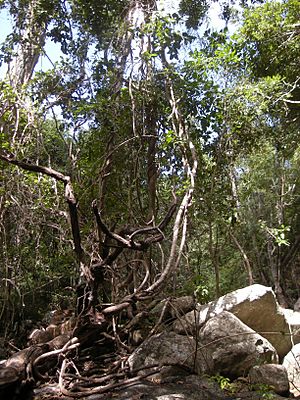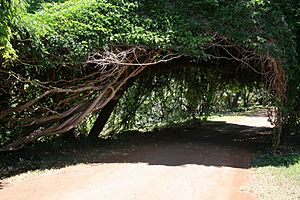Liana facts for kids



A liana is a special kind of plant that grows like a long, woody vine. It starts rooted in the ground and then climbs up trees or other tall things to reach the sunlight high in the forest canopy. The word "liana" doesn't mean a specific type of plant family. Instead, it describes how the plant grows, just like "tree" or "shrub" describe other growth habits. The word comes from French, meaning something that ties or binds.
Contents
Where Lianas Live and Grow
Lianas are very common in tropical rainforests, especially in places where the seasons change. You can also find them in cooler, temperate rainforests and forests where trees lose their leaves. Some well-known lianas in cooler areas include types of Clematis and wild grapes (Vitis).
Lianas can form natural bridges high up in the forest canopy. These bridges are like highways for arboreal animals, meaning animals that live in trees. They can use these lianas to travel from one tree to another without touching the ground. These liana bridges can also help protect weaker trees from strong winds.
However, lianas also compete with forest trees for important things like sunlight, water, and nutrients from the soil. Forests without lianas can actually produce much more fruit – about 150% more! Trees that have lianas growing on them are twice as likely to die. Some lianas can grow incredibly long. For example, a type of Bauhinia in Suriname has been found to be 600 meters (about 2,000 feet) long! One Entada phaseoloides liana was even recorded at 1.5 kilometers (almost a mile) long. The longest known liana that is a monocot (a type of flowering plant) is Calamus manan, which can reach exactly 240 meters (about 787 feet).
Lianas can belong to many different plant families. One way to tell a liana from a tree or shrub is by how stiff their stems are. Trees and shrubs have flexible young twigs but very stiff, old trunks. Lianas often have stiff young parts, but their older stems near the ground can be more flexible.
How Lianas Affect Other Plants
Lianas can cause problems for the trees they climb on. They can slow down how much trees grow and how well they reproduce. They also make it more likely for trees to die and can stop new tree seedlings from growing. This changes how forests grow back after disturbances.
Even though lianas can help support trees during strong winds, they can also be destructive. If one tree falls, the lianas connecting it to other trees might pull down many more trees, causing a domino effect.
Trees that have lianas growing on them grow slower. Lianas can directly hurt their host trees, making them more likely to be damaged by ice and wind. They also increase the chance that the host tree will fall. Lianas can also make it easier for animals that eat leaves to reach the tree's canopy. This includes ants, other insects, lizards, rodents, sloths, monkeys, and lemurs. Because of these negative effects, trees that can stay free of lianas have an advantage. Some tree species have even developed special ways to avoid or get rid of lianas.
Examples of Liana Plants
Many different plant families include liana species. Here are some examples:
- Gnetophyta
- Acanthaceae
- Thunbergia, such as T. grandiflora
- Anacardiaceae
- Toxicodendron (like poison ivy)
- Annonaceae
- Uvaria
- Apocynaceae
- Stephanotis
- Arecaceae (Palms)
- Calamus (rattan palms)
- Araceae
- Pothos
- Aristolochiaceae
- Aristolochia (Dutchman's pipe)
- Bignoniaceae
- Pyrostegia (flame vine)
- Capparaceae
- Capparis
- Celastraceae
- Celastrus (bittersweet)
- Dioscoreaceae
- Dioscorea (some yams)
- Fabaceae (Legumes)
- Entada (sea beans)
- Mucuna (velvet bean)
- Wisteria
- Flagellariaceae
- Flagellaria indica
- Nepenthaceae
- Nepenthes (pitcher plants)
- Nyctaginaceae
- Oleaceae
- Jasminum (jasmine)
- Rosaceae
- Rosa banksiae (Lady Banks' rose)
- Sapindaceae
- Paullinia
- Smilacaceae
- Smilax (greenbrier)
- Vitaceae (Grape family)
- Parthenocissus (Virginia creeper)
- Vitis (wild grapes)
|
See also
 In Spanish: Liana (trepadora) para niños
In Spanish: Liana (trepadora) para niños


